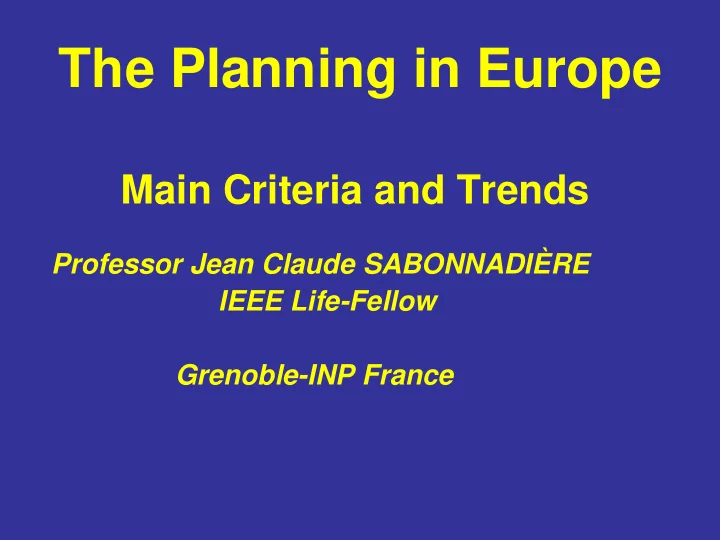

The Planning in Europe Main Criteria and Trends Professor Jean Claude SABONNADIÈRE IEEE Life-Fellow Grenoble-INP France
EUROP is worrying with Climate The policy of European Union is based on three main objectives: – Reduce CO² Emission – Act for Energy Independence and security – Adapt its Energetic system to the future needs
SmartGrids Objectives • Develop a shared vision for the future which encourages the engagement of multiple, independent parties • Identify research needs and build support for an increased public and private research effort on electricity networks • Align ongoing RTD projects and new European, national and regional programmes on electricity transmission and distribution systems • Draw conclusions and recommendations for follow-up actions and implementation of the strategic research agenda and deployment plan
Shared Vision Sustainability, competittion, security of supply • Flexibility: fulfilling customers needs • Accessibility: to all network users, particularly RES and high efficiency DG with zero or low CO2 emissions • Reliability: assuring and improving Quality of Supply and resilient to hazards and uncertainties • Economics: best value through innovation, efficient energy management and level playing field competition and regulation
Vision Elements • Toolbox of proven technical solutions, rapidly deployed and cost effective to enable power injection for all sources into the existing grid • Harmonising regulatory and commercial frameworks in Europe, facilitating cross border trading • Establish shared technical standards and protocols for open access and manufacturer independency • Information, computing and telecommunication (ICT) systems for innovative service arrangements, improve efficiency and enhanced services • Interfacing of new and old designs of grid equipment to ensure inter-operability and control
European Electricity Networks in Transition
Future Requirements • Customers are part of the “network - loop”, both producer and consumer = “prosumer” – Real-time price information (smart meters) – Automated systems + convenience (DR/DSM) – Adequate investment and reward incentives • Integration of millions small scale generators • Bulk power and small scale sustainability coexistence • Demand and supply balancing solutions • Efficiently operated (and reliable) network • Differentiated Power Quality at connection point • Mature markets and regulation
Future Network Vision • Microgrids: LV networks with DG sources, local storage, controllable loads, automatic islanding • Virtual Utilities: configure and deliver • Internet model: customer in control
Points of Interest • Technical, commercial and regulatory solutions • Central and distributed generation • Integration of innovative technologies • Harmonisation of equipment standards • Improved cross-border flow • Higher education and skills • Increased funding to make it happen
Recommend
More recommend